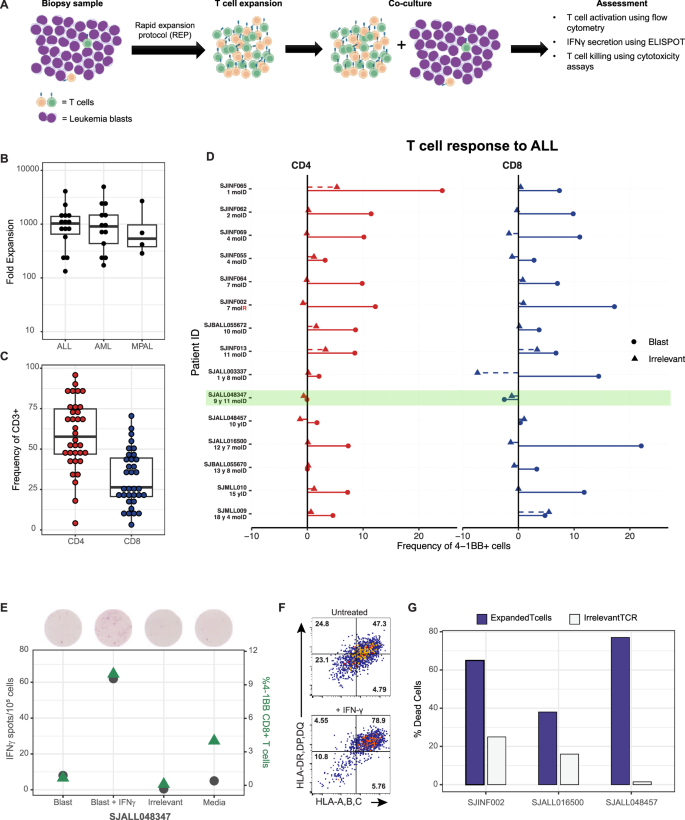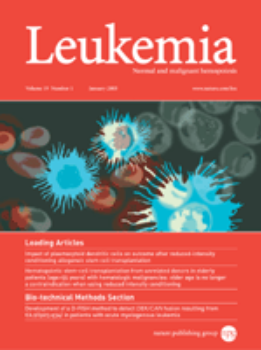Endogenous T cell responses to fusion-derived neoantigens in pediatric acute leukemias
IF 13.4
1区 医学
Q1 HEMATOLOGY
引用次数: 0
Abstract
Pediatric patients with fusion-driven leukemias frequently have a poor prognosis and need more effective therapies. Adoptive T-cell therapies, using expanded autologous T cells, have shown promise as an immunotherapeutic for patients with tumors characterized by high mutational burdens. However, this approach has not been shown to be effective in pediatric leukemias. In this study, we analyzed samples from pediatric patients with fusion-driven acute lymphoblastic, acute myeloid, and mixed phenotypic leukemias, including those with KMT2A-rearrangements. T cells were attained from bone marrow samples, expanded, and their reactivity against autologous leukemic blasts was tested. Strikingly, we observed leukemia-reactive T cells in nearly all patients (33 of 34) at diagnosis or relapse. Furthermore, some patients contained clones reactive to fusion neoantigens and other tumor-associated antigens, and candidate samples were further enriched by selecting for PD1hi and CD39+ T-cell populations. These clones were only present at the initial diagnostic timepoint and could not be detected at later times after treatment, even with deep sequence profiling. Altogether, our data suggest that adoptive T cell therapy, using expanded leukemia-reactive T cells identified at diagnosis, has potential as a novel therapeutic for these patients.


内源性T细胞对儿童急性白血病融合源性新抗原的反应
小儿融合驱动白血病患者往往预后不良,需要更有效的治疗。过继T细胞疗法,使用扩增的自体T细胞,已经显示出作为一种具有高突变负担特征的肿瘤患者的免疫治疗的希望。然而,这种方法尚未被证明对儿童白血病有效。在这项研究中,我们分析了来自融合驱动的急性淋巴细胞白血病、急性髓细胞白血病和混合表型白血病患儿的样本,包括那些kmt2a重排的患儿。从骨髓样本中获得T细胞,扩增,并测试其对自体白血病母细胞的反应性。引人注目的是,我们观察到几乎所有患者(34名中的33名)在诊断或复发时都有白血病反应性T细胞。此外,一些患者含有对融合新抗原和其他肿瘤相关抗原有反应的克隆,候选样本通过选择PD1hi和CD39+ t细胞群进一步富集。这些克隆仅在最初的诊断时间点出现,在治疗后的后期无法检测到,即使是深度序列分析。总之,我们的数据表明,过继T细胞疗法,使用诊断时识别的扩增白血病反应性T细胞,有可能成为这些患者的一种新型治疗方法。
本文章由计算机程序翻译,如有差异,请以英文原文为准。
求助全文
约1分钟内获得全文
求助全文
来源期刊

Leukemia
医学-血液学
CiteScore
18.10
自引率
3.50%
发文量
270
审稿时长
3-6 weeks
期刊介绍:
Title: Leukemia
Journal Overview:
Publishes high-quality, peer-reviewed research
Covers all aspects of research and treatment of leukemia and allied diseases
Includes studies of normal hemopoiesis due to comparative relevance
Topics of Interest:
Oncogenes
Growth factors
Stem cells
Leukemia genomics
Cell cycle
Signal transduction
Molecular targets for therapy
And more
Content Types:
Original research articles
Reviews
Letters
Correspondence
Comments elaborating on significant advances and covering topical issues
 求助内容:
求助内容: 应助结果提醒方式:
应助结果提醒方式:


